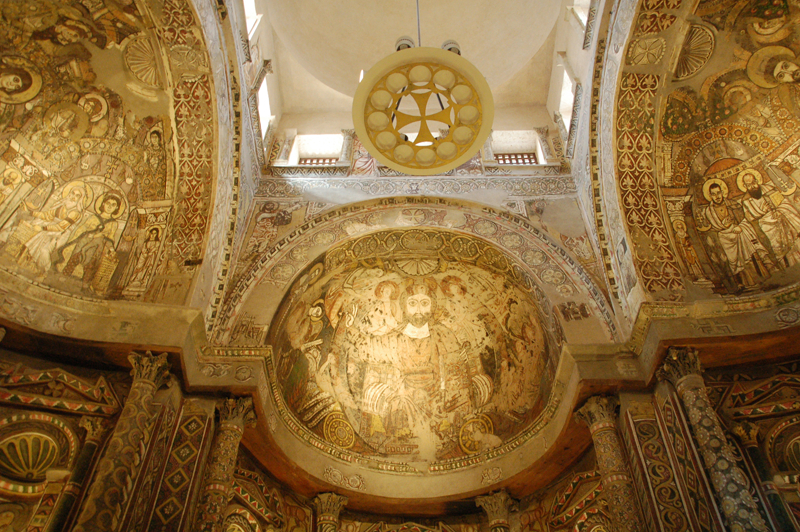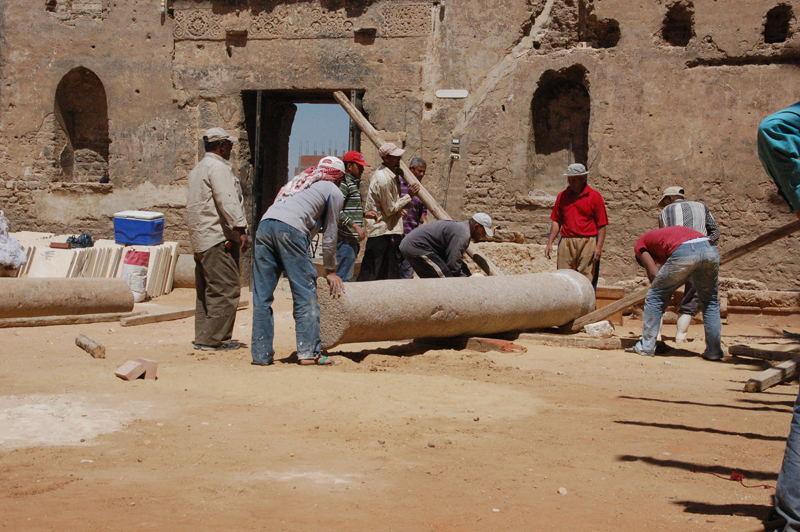- EraCoptic
- Project DirectorNicholas Warner
- LocationSohag
- AffiliationAmerican Research Center in Egypt (ARCE)
- Project SponsorUSAID
- Project Dates2015-2018
For decades, visitors to the famous but deteriorating Red Monastery church in Sohag encountered only blackened, gloomy hints of what once was among Byzantine Egypt’s most glorious painted sanctuaries. Today, the bright wonders of those ancient wall paintings have been restored at this important center for worship.
Since 2003, much of the work at the Coptic Orthodox monastery has been supported by the U.S. Agency for International Development through the American Research Center in Egypt. Because the central basilica has been in ruins for periods of its 1400-year history, the conservation efforts have presented challenges as complex as the site’s mysterious, complicated life. Workers had to address problems of previous, faulty restoration and replace and repave floors in ways to keep the ancient walls from collapsing. From lighting to stonework, from a new altar to re-used columns, the multinational preservation team worked with the Egyptian Ministry of Antiquities to deal with everything from termite and bird damage to leaky roofs and replacement doors customized to fit ancient imperfections in design.
When painting restoration finished in 2010-11, work began on architectural conservation, restoration and presentation. It was the first serious conservation effort at the monastery since the Comite de Conservation des Monuments de l’Art Arabe completed its work more than a century ago in 1909-12. The project had to deal with the complications of an active place of worship. The church was supposed to be re-consecrated, but Coptic Orthodox services don’t allow laity into the sanctuary where most of the paintings are located. At the same time, conservators wanted to ensure maximum visibility and protection of the artwork. In some ways, these efforts proved more complex than the painting conservation because the goal was to re-consecrate the Coptic Orthodox church for services. Clergy, conservators, art historians and Ministry of Antiquities representatives collaborated on these complex decisions.
The ancient floor presented an unusual challenge. In 2013, representatives of the church removed a poor-quality, uneven concrete slab that had been installed more than 15 years earlier. The new floor had to be engineered with more care, and dense to counteract pressure from the weight of building that forced the ground beneath the church upward. The conservation team installed a heavy limestone floor on sand, with mortar used only for jointing. The slabs that pave the three sanctuary recesses – the triconch – and the adjoining platform were brought from a quarry in Tura and finished by hand using an axe-like adze tool on site.
Removing the floor revealed archaeological secrets and additional problems. Workers found an area of original limestone paving in the north section of the nave, the original steps leading to the platform in front of the sanctuary and traces of mudbrick walls that once protected the paintings.
The size, location and appearance of a new altar for the church engendered considerable debate. Ultimately, an altar installed in the 1909-12 Comite restoration in the east lobe of the triconch was replaced by one in a new, central position below the dome. The new altar is a simple plastered cube topped by a slab of Italian Carrara marble. Two stone column emplacements from the 1912 altar remained in the east lobe, and a large limestone block carved with a cross – reused in the masonry of the 1912 altar – is displayed in the north side room of the church.
Workers also had to contend with a jumble of architectural debris that had gathered in the church’s nave. Some of the most significant stone fragments were rescued and displayed during the restoration work. Principal among these was a large, carved, limestone column topper, likely from the colonnades that divided the nave aisles. The topper had been reused as a pestle for grinding and the resulting damage required major restoration work before it could be installed on an existing granite column shaft on the south side of the nave. This column now mirrors a surviving black granite shaft on the north side of the nave in front of the Comite-period wall enclosing the sanctuary.
Other rescued items include four small limestone cornice blocks carved with slit modillions, foliage and star patterns. These are displayed in a recess on the south wall in front of the sanctuary facade. They share this space with another, more modern, relic of the history of the church: a wooden screen separating the nave from the sanctuary. The 19th-century partition moved to the south wall, with its central window converted into a cupboard where the faithful can leave written prayers.
Workers also faced natural foes. Encouraged by increased activity at the site and the re-cultivation of the surrounding desert, pigeons covered some architectural features of the church under thick layers of guano. To block the birds from the interior, the team installed metal mesh in many small light apertures around the perimeter and added mesh screens to larger modern windows.
Termites were another plague, attracted by ground moisture from agricultural irrigation or water seeping from adjacent new buildings. Treatments varied by location. Before the new stone floor was installed, workers covered the area with dry lime. The project thwarted damage in three separate areas of woodwork inside the church and throughout planking in the roof, where proper drainage had to be restored.
One aspect of recent work is often overlooked by visitors: lighting to highlight the radical transformation of the wall paintings from dull black to vivid polychrome. Philips Lighting Egypt developed a strategy reliant on warm spectrum LED fixtures and discreet installation. Such lights have no UV or heat emissions and an extremely long life span, and the team managed to install all the lighting without a single nail or screw in any of the original architectural features. Outside, a single spotlight is trained on the new wooden cross mounted on the dome. All of these structural and architectural improvements enhance and showcase the powerful restoration and conservation efforts at one of the world’s best-preserved Byzantine structures.

